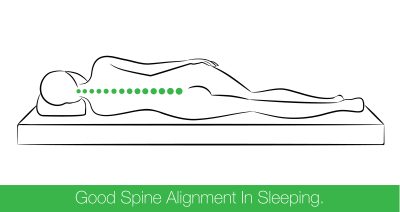Learn how to sleep with lower back pain…mattresses and positioning are the keys
The best mattress for back pain walks you through the research showing how a medium firm mattress has been PROVEN to reduce chronic lower back pain.
Well, what if you have a medium firm mattress and still have back pain after sleeping? What if you don’t want to invest in a new mattress at the moment? Then at the very least, you MUST make certain you’re sleeping in positions that are spine friendly.
What Are Spine Friendly Sleeping Positions?
In the simplest of terms spine friendly sleeping positions maintain your lumbar spine in a neutral position. The easiest way to conceptualize a neutral spine position is to use your finger. Take the tip of your right index finger. Use the thumb and index finger of your left hand to bend the the tip of your right finger back. Just feels like you’re bending your finger back, right? Now, hold the tip of your right index finger bent back for two or three minutes. Your finger probably starts to feel a little less comfortable. Imagine holding your finger in this position for hours. It would become painful and stiff.
This is essentially what happens with the joints and soft tissues of your lumbar spine if you’re not sleeping in the correct positions. When you first lie down, even if you’re in a great position, your back is fine. Just like when you first bend your finger back, it feels fine. After hours of being in a position that puts excessive forces through your lumbar spine pain and stiffness set in. Next thing you know you’re waking up in the morning to back pain. Or worse, being woken up in the middle of the night because your back hurts.
I Have Back Pain After Sleeping, What Position Should I Sleep In?
There are basically four positions you can sleep in. Back, stomach, left side, right side. The good news is you can sleep in any of these positions, even if you have back pain! So you should sleep in the position that you’re most comfortable in, that’s natural to you. Trying to sleep in a position that doesn’t work for you negatively affects your sleep and won’t help with your back pain if you don’t know how to set it up.
The best sleeping position for lower back pain keeps the natural curve in the lumbar spine.
This can be accomplished relatively easily with the use of pillows.
Pillows can be used to keep the lumbar spine in a neutral position, maintaining the natural lordosis if you’re a back sleeper, side sleeper, or a stomach sleeper.
While the positioning changes using pillows is fairly subtle, they make a marked difference. Sleeping position is often overlooked and has the potential to be a game changer. Give these positions at least two weeks to work their magic. After a month of consistently sleeping in the correct positions you will have less back pain, no doubt about it.
Once you’re waking up and feeling good, start moving! The Lower Back Health Blueprint outlines the perfect four week back and core strengthening program.
When this program becomes too easy check out the Crush Back Pain Programs for proven methods to beat back pain.
To become less painful the tissues in your lower back need to heal. Sleep is the prime time for healing and desensitization. If your lower back is stiff and painful in the morning the tissues are not getting the opportunity to heal.
Modify your sleeping positions and get the right mattress. Make sleep a time that facilitates healing of your lower back.
For more videos that show you how to beat back pain subscribe to the Crush Back Pain channel .



